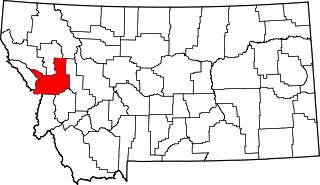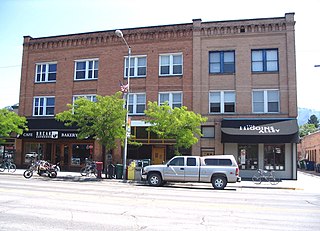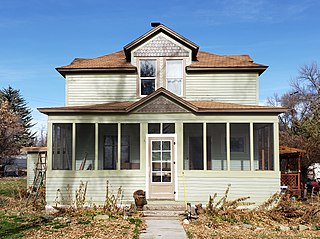
Missoula is a city in the U.S. state of Montana; it is the county seat of Missoula County. It is located along the Clark Fork River near its confluences with the Bitterroot and Blackfoot Rivers in western Montana and at the convergence of five mountain ranges, thus it is often described as the "hub of five valleys". In 2019, the United States Census Bureau estimated the city's population at 75,516 and the population of the Missoula Metropolitan Area at 118,791. After Billings, Missoula is the second-largest city and metropolitan area in Montana. Missoula is home to the University of Montana, a public research university.

First Ladies National Historic Site is a United States National Historic Site located in Canton, Ohio. During her residency in Washington, D.C. Mary Regula, wife of Ohio congressman Ralph Regula, spoke regularly about the nation's first ladies. Recognizing the paucity of research materials available she created a board to raise funds and for a historian to assemble a comprehensive bibliography on American first ladies. From these inspirations came a National First Ladies’ Library, established in 1996, and the First Ladies National Historic Site. The site was established in 2000 to commemorate all the United States first ladies and comprises two buildings: the Ida Saxton McKinley Historic Home and the Education & Research Center. Tours start at the Education & Research Center, located one block north of the Saxton McKinley house on Market Avenue. The 1895 building, formerly the City National Bank Building, was given to the National First Ladies’ Library in 1997.

The Izaak Walton Inn is a historic inn in Essex, Montana, USA. It was originally built by the Great Northern Railway in 1939 for lodging railway workers. In addition to railway lodging, the hotel was also originally envisioned as a potential official southern gateway to Glacier National Park, but that plan never materialized. Today, the inn is at the only request stop on Amtrak's Empire Builder route. A van from the inn meets both the morning eastbound and the evening westbound Empire Builders to convey passengers between the Essex station and the inn.

The Magnolia Mound Plantation House is a French Creole house constructed in 1791 near the Mississippi River in Baton Rouge, Louisiana. Many period documents refer to the plantation as Mount Magnolia. The house and several original outbuildings on the grounds of Magnolia Mound Plantation are examples of the vernacular architectural influences of early settlers from France and the West Indies. The complex is owned by the city of Baton Rouge and maintained by its Recreation Commission (BREC). It is located approximately one mile south of downtown.

Traveler's Rest was a stopping point of the Lewis and Clark Expedition, located about one mile south of Lolo, Montana. The expedition stopped from September 9 to September 11, 1805, before crossing the Bitterroot Mountains, and again on the return trip from June 30 to July 3, 1806. Traveler's Rest is at the eastern end of the Lolo Trail. It was declared a National Historic Landmark in 1960 and added to the National Register of Historic Places in 1966. The boundaries were subsequently revised, and mostly lie within the 51-acre (21 ha) Traveler's Rest State Park, which is operated by the Montana Fish, Wildlife & Parks. Significant archeological findings made in 2002, including latrine sites with traces of mercury and fire hearths, make this the only site on the Lewis and Clark National Historic Trail that has yielded physical proof of the explorers' presence. Records made by Lewis and Clark often spell "Traveler's" as "Traveller's". This spot is largely unchanged from the days of Lewis and Clark. From this location, Lewis and Clark split up to explore Montana during their return trip, not reuniting until they reached Sanish, North Dakota.

The Wilma was built in 1921 by William "Billy" Simons and dedicated to his wife, light opera artist Edna Wilma. Designed by Norwegian architect Ole Bakke and his assistant H. E. Kirkemo, the steel-framed highrise features hallmarks of Sullivanesque architecture. Wilma is part of an eight-story complex that was the first steel-framed high-rise building in Missoula, and includes the main 1400-seat hall, a lounge, three banquet rooms, a restaurant, apartments and offices. The theater interior is decorated with Louis XIV Style gilt trim.

The Milwaukee Depot in Missoula, Montana, was built by the Chicago, Milwaukee, St. Paul and Pacific Railroad in 1910 as part of the railroad's transcontinental "Pacific Extension".

This is a list of the National Register of Historic Places listings in Missoula County, Montana. It is intended to be a complete list of the properties and districts on the National Register of Historic Places in Missoula County, Montana, United States. The locations of National Register properties and districts for which the latitude and longitude coordinates are included below, may be seen in a map.

Belmont Hotel is an hotel in Missoula, Montana. Built in 1913, it was listed on the National Register of Historic Places in 1983.
Notes on the University of Montana's collection of Belmont Hotel registers say "The Belmont Hotel was located at 430 North Higgins Avenue in Missoula, Montana, and was in business from 1911 to 1972. For the most part it operated as a railroad hotel, offering, for example, in 1927, services such as steam heat, electric light, telephone service, hot and cold water baths, and reasonable rates by day or week. The establishment had numerous proprietors; however, Mrs. Lena Walker, a.k.a. Mrs. Lena Smith managed the hotel for most of the period of this (1918-1950)collection, from 1932 until 1956."

The Gleim Building, 265 W. Front St., Missoula, Montana, was a brothel constructed in 1893 for Mary Gleim, a notorious madam who owned at least eight "female boarding houses". This building serves as an example of a vernacular adaptation of Romanesque architecture.

After the University of Montana was founded in 1893 classes were temporarily held in the old Willard School until the first set of buildings were set up around the oval in 1895. Since that time, various campus plans and architectural styles have been utilized. Today the campus consists of 156 acres and is bordered to the east by Mount Sentinel and the north by the Clark Fork River. The main campus comprises 64 buildings, a 23,500-seat football stadium and nine residence halls.

The Florence Hotel is a seven-story Moderne-style building in Downtown Missoula, Montana, which was completed in 1941. It was listed on the National Register of Historic Places in 1992.

The Atlantic Hotel, at 519 N. Higgins in Downtown Missoula, was listed on the National Register of Historic Places in 1990. The building has also been known as the Circle Square Second Hand Store, the business which it housed in 1990.

Albert John Gibson was an architect in Missoula, Montana who designed a number of buildings that are listed on the National Register of Historic Places.
The culture of Missoula, Montana is influenced by the nearby University of Montana in art, sports, and music with the city's location in a mountain river valley also encouraging outdoor events and recreation.

The Lake McDonald Lodge Coffee Shop is a visitor services building in the Lake McDonald district of Glacier National Park, Montana, USA. The coffee shop was built in 1965 as part of the National Park Service's Mission 66 program to upgrade visitor facilities, in order to increase visitor dining capacity. Under the Mission 66 projects, visitor facilities were usually comprehensive in nature, providing a range of visitor services. Specialized concession buildings like the Coffee Shop were unusual in Mission 66. It was leased to the Glacier Park Company for operation, in anticipation of the construction of lodging facilities by the company.

The Missoula station in Missoula, Montana, was built by the Northern Pacific Railway in 1901. The current structure is the third depot built in Missoula by the Northern Pacific, which reached Missoula in 1883. It was listed on the National Register of Historic Places in 1985, as the Northern Pacific Railroad Depot.

The Mrs. Lydia Johnson House is a historic residence located in Maquoketa, Iowa, United States. This house is a fine example of Queen Anne style architecture in the United States. It was built during the economic boom years in the city's development. Built in 1895, the two and one half storey house features a complex irregular composition, a corner tower, wrap-around porch, a small porch on the second floor above the main porch, various window shapes and sizes, and textured wall surfaces on the exterior. Little is known about the Johnson family who built it, but its notability is derived from the architecture. The house was listed on the National Register of Historic Places in 1991.

The Willis House is a historic residence in Encampment, Wyoming, United States, that is listed on the National Register of Historic Places.

The Hester E. Suydam Boarding House, at 209 W. River St. in Fromberg, Montana, was built in 1907. It was listed on the National Register of Historic Places in 1993.






















